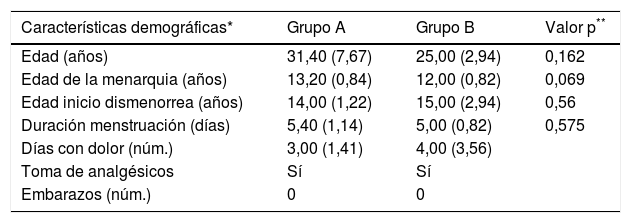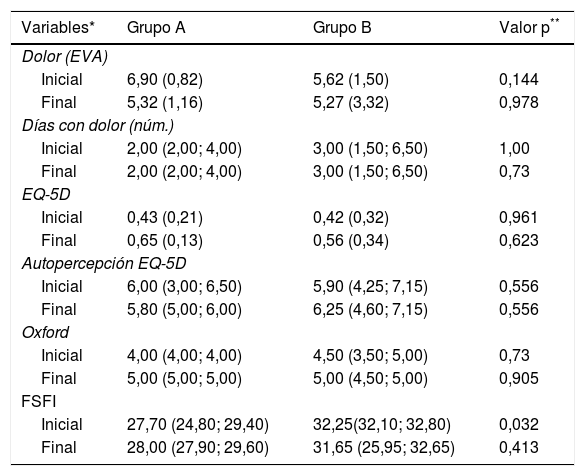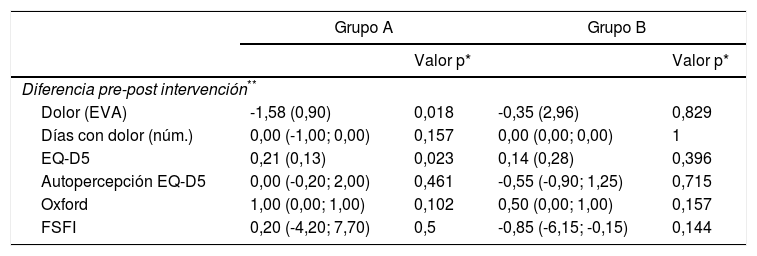La dismenorrea es el conjunto de síntomas que se pueden padecer durante la menstruación, siendo el más característico un dolor intenso. El síndrome de dolor miofascial es el conjunto de signos y síntomas que producen los puntos gatillo miofasciales (PGM) tanto en su localización como a distancia, entre otros el dolor. Por lo tanto, el objetivo del estudio es estudiar la eficacia del tratamiento fisioterápico de los PGM en musculatura abdominal, aductora y del suelo pélvico para con la afectación de las variables de dolor, función sexual, calidad de vida, fuerza y movimiento en pacientes con dismenorrea.
Material y métodosEstudio piloto aleatorizado. Se dividió a las participantes entre un grupo A (n = 6) donde se aplicó punción seca y terapia manual en musculatura abdominal, aductora de la cadera y suelo pélvico y grupo B (n = 7) donde se aplicó termoterapia y estiramientos en la misma musculatura. Las variables estudiadas fueron: dolor menstrual, función sexual, calidad de vida, rango de abducción de cadera, fuerza muscular, resistencia del suelo pélvico y existencia de puntos gatillo miofasciales. Una fisioterapeuta realizó los tratamientos y otra las valoraciones, estando cegada la segunda.
Resultadosel grupo A obtuvo una diferencia clínica (1,6 puntos menos en EVA) y estadísticamente significativa del dolor (p = 0,018), frente al otro grupo (0,4 puntos, p > 0,05), así como una mejora en la calidad de vida (p < 0,05) del grupo A. No se hallaron cambios significativos en el resto de las variables.
Conclusiónexiste un alivio significativo del dolor y mejora de la calidad de vida del grupo A. Se considera así que el tratamiento específico del síndrome de dolor miofascial puede presentar mayor eficacia clínica.
Se concluye la necesidad de continuar esta investigación con una mayor muestra de participantes, con el fin de esclarecer la eficacia del tratamiento de fisioterapia para el resto de las variables estudiadas.
The term dysmenorrhoea defines different symptoms that women can feel during menstruation, the most common being intense pain. Myofascial pain syndrome (MPS) is the combination of signs and symptoms caused by myofascial trigger points (MTP), at their site or at a distance. Therefore, the objective of this study is to evaluate the efficacy of a treatment for MTP in the abdominal, hip adductor and pelvic floor muscles, from a physiotherapeutic approach, regarding the following outcome measures: pain, sexual function, quality of life, strength and mobility in patients suffering from dysmenorrhoea.
Materials and methodsRandomized pilot study. Participants were divided into two groups: A (n = 6), where dry needling and manual therapy was applied to the abdominal, hip adductor and pelvic floor muscles; and B (n = 7), where the participants received thermotherapy and stretching of these muscles. The outcome measures studied were menstrual pain, sexual function, quality of life, hip abduction range of motion, strength of the affected muscles, pelvic floor muscle endurance and finding myofascial trigger points. All the treatments were provided by the same physiotherapist, while a different physiotherapist carried out the evaluations blinded to each patient's group.
Resultsin group A, a clinically (1.6 less in VAS) and statistically significant reduction (p = 0.018) in pain was observed in comparison with group B (.4 in VAS, p > 0.05). Quality of life also improved in the first group (p< 0.05). No further significant differences were found in the remaining outcome measures.
Conclusionsa significant improvement was observed with regards to pain and quality of life in group A. Thus, we consider that specific treatment for MPS could be more clinically effective.
We conclude that this research should be continued with a larger sample of participants, in order to clarify the efficacy of the physiotherapy treatment suggested for the remaining outcome measures.
Article
Si ya tiene sus datos de acceso, clique aquí.
Si olvidó su clave de acceso puede recuperarla clicando aquí y seleccionando la opción "He olvidado mi contraseña".










